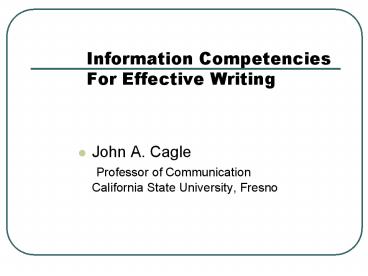Information Competencies For Effective Writing - PowerPoint PPT Presentation
Title:
Information Competencies For Effective Writing
Description:
Purpose and Decision to Start Problem exigency gives rise to need for solution and communication Build your personal motivation for the ... quotations, statistics ... – PowerPoint PPT presentation
Number of Views:94
Avg rating:3.0/5.0
Title: Information Competencies For Effective Writing
1
Information Competencies For Effective Writing
- John A. Cagle Professor of Communication
California State University, Fresno
2
Purpose and Decision to Start
- Problem exigency gives rise to need for solution
and communication - Build your personal motivation for the tasks
ahead - Purpose of writing determined informative,
persuasive, entertaining - Plan how to use your time well
3
Research
Finding Information
4
Need for Information
- Before you can speak, you've got to have
something to say. - Speaking and writing should be based on truth.
- Use scholarly tools to facilitate research -- the
quest for information and knowledge.
5
Problem Question
- Purpose, interests, what you know about your
topic and are interested in - Process begins with forming a problem question to
guide your research. - The problem question is what we expect to answer
through our research. - Often the question is initially general, but it
gets refined as you begin and continue your
research.
6
Generate Information Needs and Questions
- What kinds of things will you need to know to
answer the question? Who? What? When? Where?
Why? How? What are the facts? What are the
critical events? What is the timeline in the
history of the problem? What are the causes and
effects in a problem? - identify topics or specific questions
- seek information to answer by using personal,
documentary, library, and Internet resources
7
Techniques to Explore, Discover, and Develop Ideas
- brainstorm lists
- focused freewriting
- clustering
- thinking
8
Access Research Sources
9
Reads, Notes, and Records
10
Critically Analyze and Evaluate Information
11
Organize and Synthesize Information
- Academic writing in all fields today still
follows the basic organizational plan recommended
by Cicero - Exordium
- Narratio
- Partitio
- Confirmatio
- Conclusio
12
Invention
Planning what to say
13
Thesis
- State WHAT you want to say in the speech in a
single sentence. - The central idea of the speech or essay is called
a thesis. - Remember that the thesis should be appropriate to
the scope and purpose of the assignment and the
occasion.
14
Development
- Development is the expansion of the thesis,
identifying the main lines of development, the
major arguments proving your point, and so forth. - Types of developmental material include
definitions, facts, quotations, statistics,
comparisons, contrasts, examples, illustrations,
and so forth.
15
Criteria for Developmental Materials
- Audience attitude
- Timeliness
- Authoritativeness
- Relevance or appropriateness
16
Organizing
Planning the introduction, body, conclusion
17
Introduction
- Exordium Secure attention and interest.
- Narratio Give needed background on topic (what
does audience need to understand to appreciate
your points? - Partitio State the purpose of speech and
preview the major parts
18
Exordium
19
Partitio
- Orient audience to the thesis or purpose of
essay state the thesis directly - "The purpose of this paper is to. . . ."
- "Preview" the major developmental parts of the
essay state this directly - "First, the history of the problem will be
explored second, the consequences. . . ."
20
Partitio
Narratio (background)
21
Summary at end of Narratio
22
Body (Confirmatio)
- Body of paper contains the main ideas of the
essay and appropriate developmental material. - Arrangement of the main ideas/developmental
material should be determined by the subject
matter and purpose.
23
Confirmatio (the body of the paper)
24
Conclusion (Conclusio)
- Summarize thesis and main points
- Show relevance to the course (or reason you wrote
paper) - Stimulate audience to want to know more, do
something, think of the implications of your
paper, etc.)
25
Conclusio
26
Using research in writing
Summary of findings
Signal phrase before quotation
Writers own thought
27
References at the end
28
Transitional Material
- Throughout paper, the thesis should be abundantly
clear. - Relate each main idea to thesis and to other
ideas. - Use transitional sign post words (therefore,
however, first, etc.)
29
Outline
- Outline to see the structure of your ideas
- Typical forms of outlines
- Key word outline
- Sentence outline
30
Revise Carefully
- Check for word appropriateness meaning
- Use stylistic devices to improve use of language
31
- Check for content logically sound? points well
developed? details sufficient? enough
illustrations examples? support?
32
- Check for overall structure--be sure introduction
and conclusion are effective - Check for transitions--are there enough?
- Assess the speech as you think your audience will































